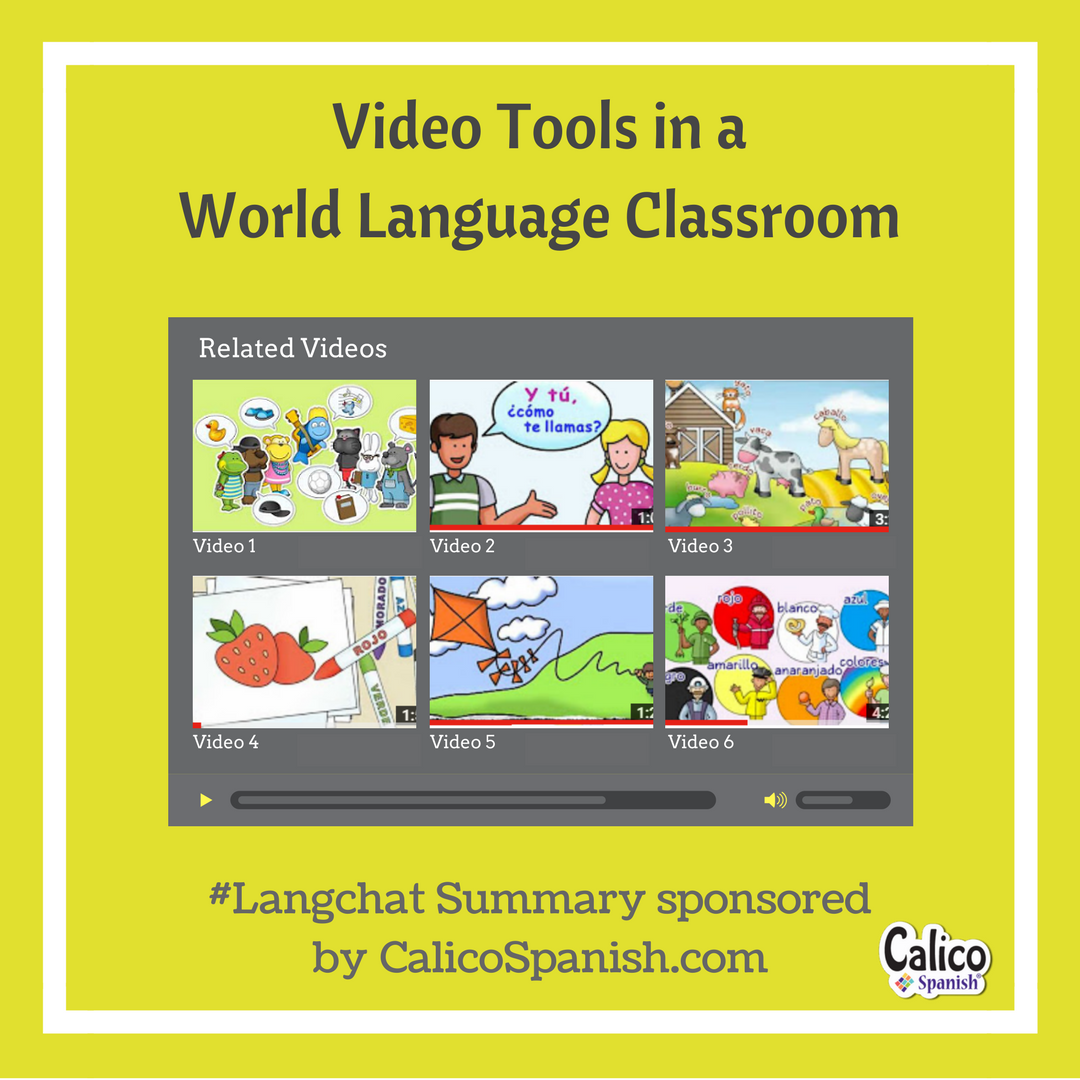Video Tools in a World Language Classroom

Exploring how video tools can impact a World Language Classroom was the theme for this #langchat discussion. Target-language videos, whether for learners or authentic, can be a fabulous tool for engaging learners of all ages, regardless of the teacher’s curriculum. On this topic, #langchat teachers discussed increasing proficiency, bridging videos into interpersonal and presentational modes, using videos to teach culture, student-created videos, and assessments around videos.
– Follow the blog on Bloglovin –
Video Activities and Strategies to Increase Proficiency
Implementing video tools in the World Language Classroom can be a fun and engaging way to increase student proficiency in a target language. Some helpful strategies and activities for language practice with videos may include, “cloze activities, spot the not, put events in order, or reenact the scene with different perspective or outcome” (@angardner06). @SraWilliams3 shared that she likes “@EDpuzzle for quick comprehension checks” She has been using the MovieTalk teaching [strategy] a lot. Even basic true or false questions or simple vocab recognition are often found to be helpful in her classroom. @BThompsonEdu suggested that #langchat participants “give [students] some phrases to listen for and tell them what they’re going to do afterwards.” For example, students from elementary school up can discuss with a partner, write, or retell what happened in the video after they watch it. @VTracy7 strategizes with “before-during-after questions.” Whatever the activity, teachers should keep in mind that “when crafting questions, seek to not just assess comprehension but use questions to actually guide and facilitate it!” (@SenorG).
– Like Calico Spanish on Facebook –
Bridging Video Instruction into Interpersonal and Presentational Modes
Although #langchat teachers prefer to focus on increasing the interpersonal mode in their classrooms, @SenorG advises “using Voicethread to record alternative audio in order to increase the Presentational Mode. Kids love narrating clips.” For the Presentational Mode, @SECottrell gives a “summary of the scene and then drops names, places, and nouns. Then, the [students] create stories with a similar framework.” This strategy works all the way down to young children, even kindergarten.
“For more interpersonal instead of presentational, [students can] create a conversation as characters in a screenshot or picture” (@nicolekb9). @nathanlutz said, “to leverage the Interpersonal Mode around viewing a video, I like to have [students] discuss opinions.” Another Interpersonal Mode strategy could include students “writing follow up questions based on the video. Allow them to ask their partners [their questions]” (@MaryBethHills).
– Follow Calico Spanish on Twitter –
Using Authentic Videos to Build Knowledge and Awareness about a Target Culture
When it comes to exploring another culture, authentic videos are a goldmine. Teachers shared the following tips for using videos for this purpose.
- @LesliePhillips3 said, “analyze clips with products, practices and perspectives.”
- @ADiazMora said, “bring problems to [the student’s attention such as videos about environmental problems etc. Crude on Edpuzzle or Recycled Life on youtube” are great video tools.
- @MmeFarab stated “It’s one thing to tell [students] about culture, another to let them watch it and see it.”
- @welangley shared, “authentic resources videos can show contexts that we cannot make realistic in class.”
- @MlleSulewski said she“has to do comparisons from right off the bat. Lead with a question about own practices before showing the video [in order to build a] frame of reference.”
- @madameparkinson said, “I love using authentic commercials that are short, sweet, and easy-to-understand. They bring up a lot of questions by students about culture.”
Introduce a child you love to a lifelong journey of speaking real Spanish to real people. Click the red button to experience it FREE.
Role of Student-Created Videos in Supporting Proficiency
Student- created videos can provide opportunities for the classroom to interactively engage in the target language. “Student created videos are creative. The target language notwithstanding, students need opportunities to create in the target language” (@profedenham). @Breidjoy said, “if there are strict rules and a culture of spontaneity [without it being] rehearsed or read,” then student-created videos can easily support proficiency. Creating a video does not provide “the best input but definitely creates high engagement” (@nicolekb9). @SraStephanie shared, “I have a friend who did a lot with video threads. For example, one kid posts, another kid replies.” The most obvious way that student-created videos can support proficiency is that they can provide an opportunity for language teachers “to observe and reflect on progress and growth” (@SraWilliams3).
– Follow us on Instagram too! –
Formative and Summative Assessments Designed Around Videos
#Langchat participants concluded the discussion by sharing some of their formative and summative assessment techniques designed around video tools. @ADiazMora shared, “movie talk leads to reading and then retell; Edpuzzle videos on topic of study” are also helpful. “Everything from quick comprehension checks, to [student] self-assessments with ‘can do’s’, to full blown IPAs and beyond can involve videos” (@angardner06). @magistertalley added, “[World Language teachers could use IPA-style Interpretive questions” to assess video.
Thank You
Thanks to our lead moderator, Wendy (@MmeFarab), for helping #langchat participants explore video tools in the World Language Classroom. For all who joined and contributed to the discussion, your opinions, experiences, and advice are so valuable! Do you have something you would like to chat about? Check out our #langchat wiki and suggest a theme or topic!






No Comments